

— Products —
 Consumer hotline +8618073152920
Consumer hotline +8618073152920 WhatsApp:+8615367865107
Address:Room 102, District D, Houhu Industrial Park, Yuelu District, Changsha City, Hunan Province, China
All products
Ambient Temperature, Humidity and Barometric Pressure Sensor is a fully digitalized sensor that integrates high-precision digital temperature, humidity and barometric pressure. It can accurately and quickly detect the atmospheric temperature, humidity and air pressure, providing reliable data support for meteorology, marine, environment, airport, port, laboratory, agriculture and transportation and other fields. The sensor has a built-in signal processing unit, which can outp···
Tel/WhatsApp:+8615367865107
Email:Arvin@niubol.com +Nearly 100 partner company in more than 68 countries. We are committed to providing high-quality, practical products to meet your needs and help you solve problems.Product Details
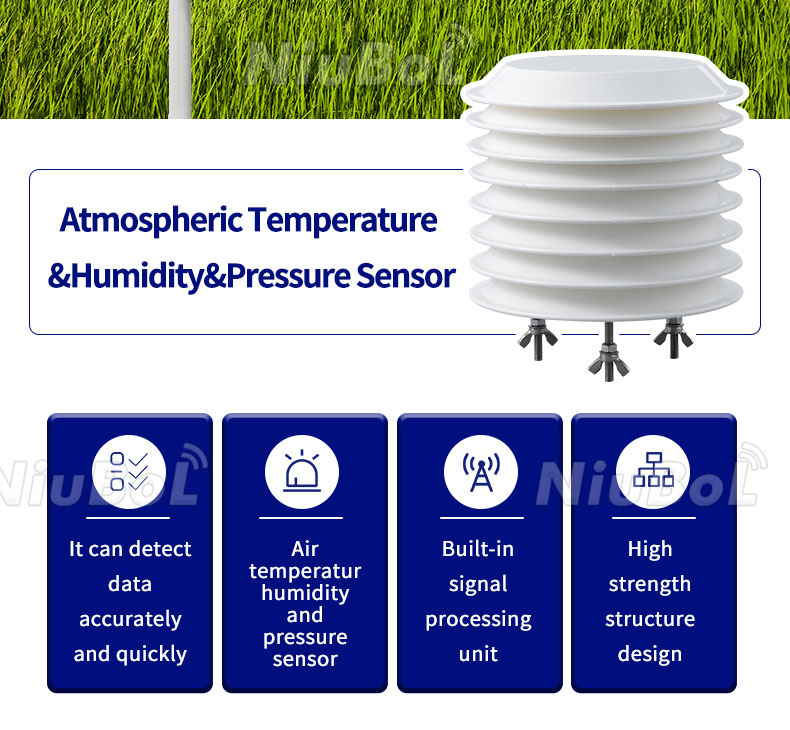
Ambient Temperature, Humidity and Barometric Pressure Sensor is a fully digitalized sensor that integrates high-precision digital temperature, humidity and barometric pressure. It can accurately and quickly detect the atmospheric temperature, humidity and air pressure, providing reliable data support for meteorology, marine, environment, airport, port, laboratory, agriculture and transportation and other fields. The sensor has a built-in signal processing unit, which can output the corresponding signal according to the user's needs, and also adopts a high-strength structural design to ensure that it can still be accurately detected in harsh climatic environments.
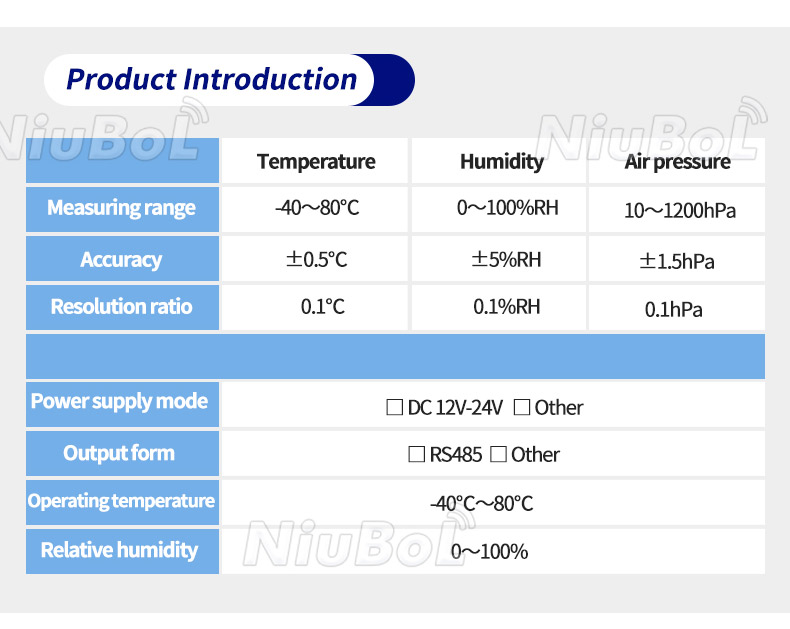
| Temperature measurement | - Measuring range: -40℃~80 - Accuracy: ±0.5℃. - Resolution: 0.1℃ |
| Humidity Measurement | - Measuring range: 0~100%RH - Accuracy: ±5%RH - Resolution: 0.1%RH |
| Barometer Measurement | - Measuring range: 10~1200hPa - Accuracy: ±1.5hPa - Resolution: 0.1hPa |
| Power supply | - DC 12V-24V |
| Output | - RS485 or 4-20mA |
| Working environment | - Operating temperature: -40~80℃ - Relative humidity: 0~100%RH |
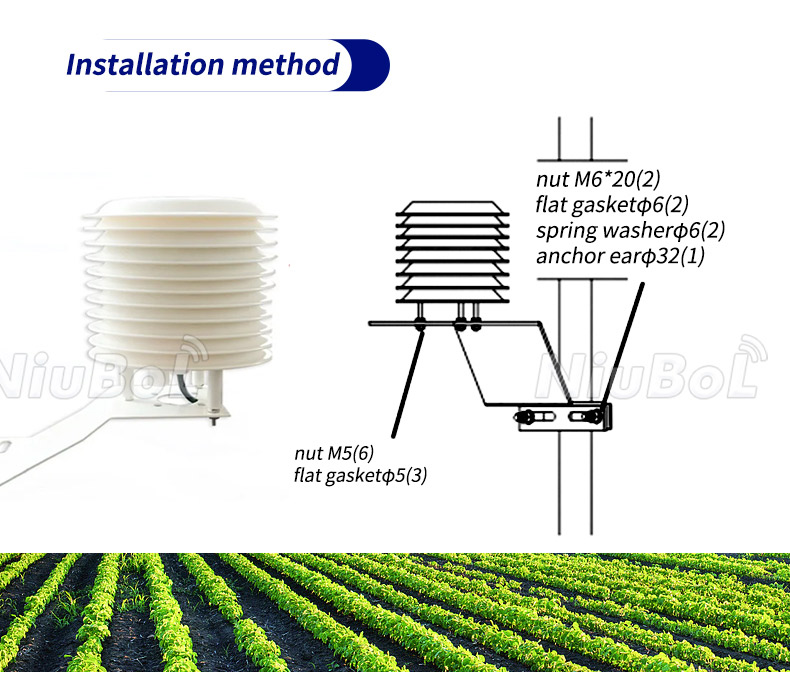
1. high precision measurement: advanced sensing technology and signal processing algorithms to ensure the accuracy and stability of the measurement results.
2. full digital detection: digital output, easy to integrate with various data acquisition systems and control systems.
3. High-strength structural design: the use of high-strength materials to ensure that the sensor can still work properly in harsh climatic environments.
4. Flexible Configuration: Support a variety of power supply and output forms, according to user needs for flexible configuration.
5. Widely used: applicable to meteorology, ocean, environment, airports, ports, laboratories, industry and agriculture, and transportation and other fields.
For the ambient temperature and humidity and barometric pressure sensors, their output forms usually include the following:
- Voltage output: The sensor converts the measured physical quantity into a voltage value for output through internal circuitry. For example, a temperature measurement may correspond to a voltage output proportional to the temperature, and similar voltage outputs may be used for humidity and barometric pressure measurements.
- Current Output: Similar to a voltage output, a sensor may convert a measurement into a current for output. This type of output may be more stable in some applications because the current signal is less susceptible to line resistance.
- Serial communication interfaces: e.g. RS485 These interfaces allow the sensor to communicate with a computer, microcontroller, or other digital device to transfer measured data. Among them, RS485 interface is especially common in industrial applications because of its strong anti-interference ability and long transmission distance.
- Switching output: In some cases, the sensor may only need to output a simple switching signal to indicate whether the measured value exceeds a certain threshold. For example, when the temperature exceeds a set point, the sensor may output a high level signal to trigger an alarm or control device.
- Mixed analog/digital output: Some sensors may provide both analog and digital output forms to meet the needs of different application scenarios.
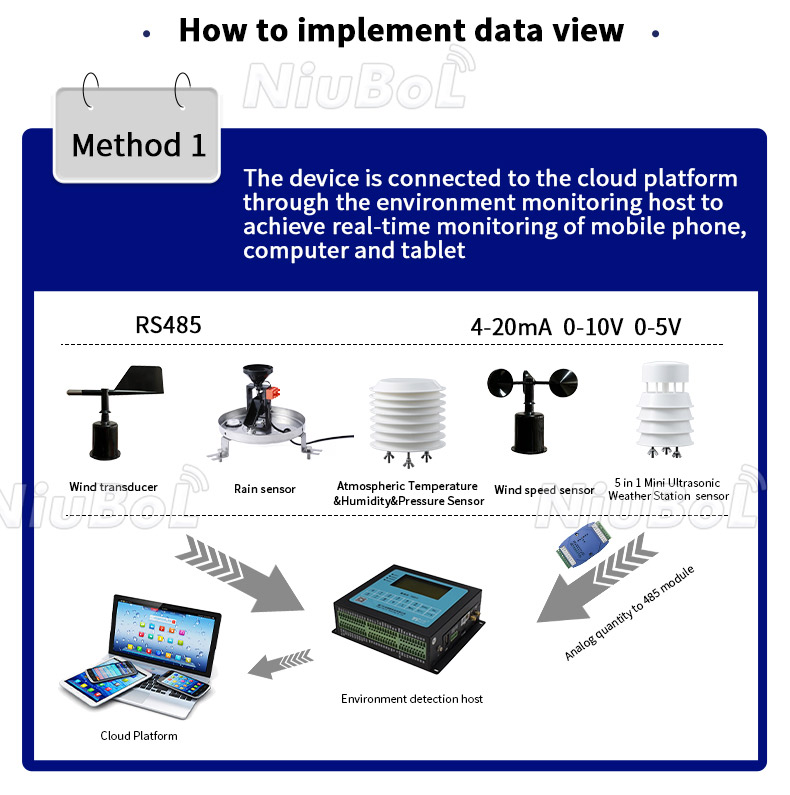
Temperature and humidity sensors have a variety of power supply methods to meet the needs of different applications:
- Common way: DC 12V or 24V, suitable for fixed installation and stable power supply occasions.
- Portable or remote area use: for sensors that need to be moved or are not easily connected to an external power source.
- Outdoor agricultural applications: especially suitable for outdoor agricultural applications, to achieve long-term maintenance-free operation, especially for remote or well-lit areas.
Selection of the appropriate power supply needs to be based on the use of the sensor environment, continuous operation requirements and maintenance convenience to decide. In the agricultural field, taking into account the long-term stability of the equipment and maintenance costs, low power consumption and renewable energy power supply scheme is often preferred.
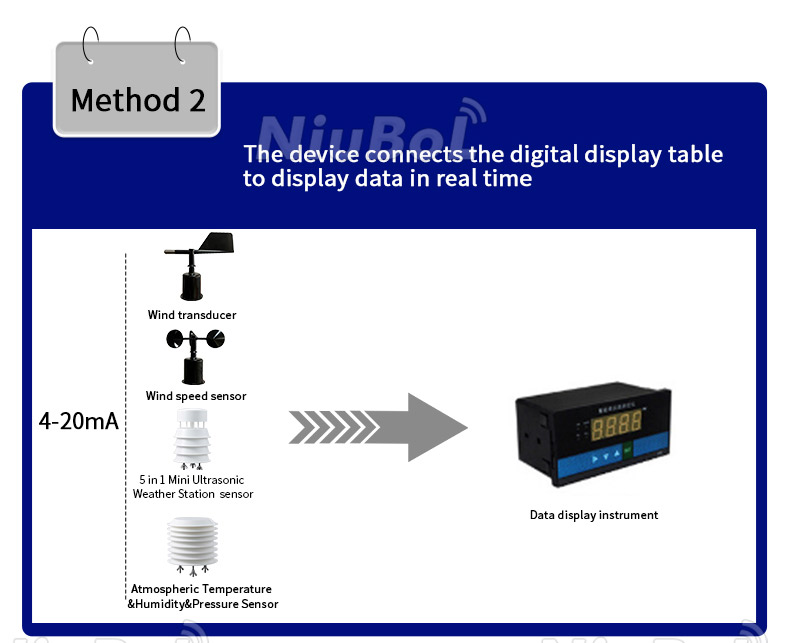
- Weather monitoring: Used in weather stations to provide accurate weather data.
- Environmental monitoring: used for monitoring environmental temperature, humidity and air pressure, assessing environmental quality and warning of natural disasters.
- Industrial Control: Used for temperature, humidity and air pressure monitoring of industrial equipment to ensure the normal operation of the equipment.
- Agricultural irrigation: Based on the temperature and humidity data of soil and air, optimize the irrigation strategy to improve crop yield.
- Traffic management: used to monitor the temperature, humidity and air pressure of roads and bridges to ensure traffic safety.
When choosing a temperature and humidity sensor for agriculture, you need to consider the following key factors:
- Accuracy: Choose a sensor with an accuracy between ±2%RH and ±5%RH to ensure data reliability.
- Stability: A stable sensor reduces the accumulation of errors in long-term use.
- Protection class: at least IP65 to resist dust and rain from farmland.
- Corrosion resistance: Choose sensors made of stainless steel or corrosion-resistant materials for different soil and climate conditions.
- Temperature range: Covering -30℃ to 70℃ to adapt to extreme weather.
- Power consumption: Agricultural sensors are often deployed in remote areas, and low-power or solar-powered sensors are more convenient for long-term use.
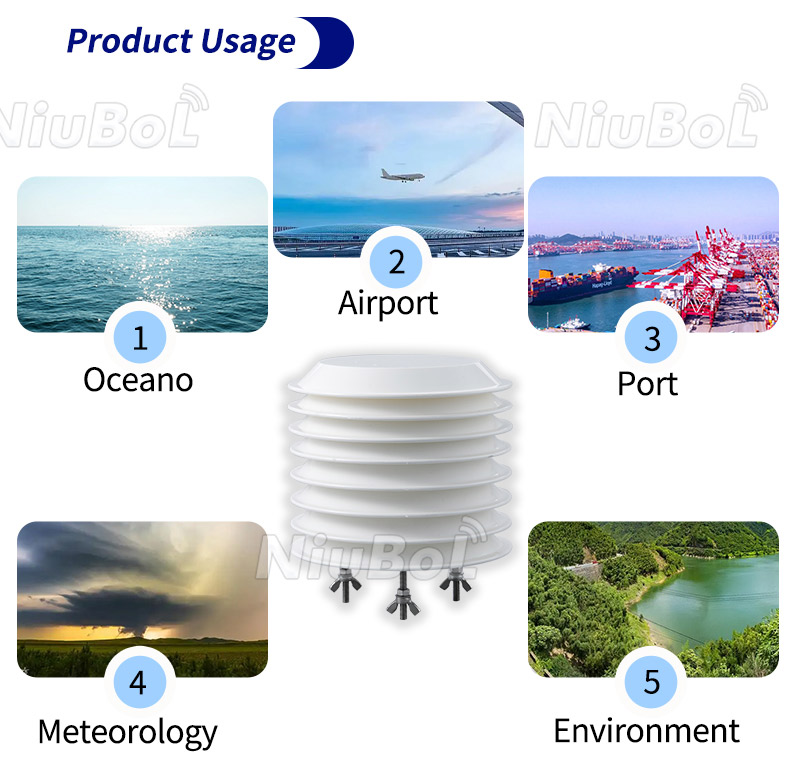
- Installation: Simple and easy to install, easy for farmers to operate.
- Maintenance: low maintenance cost, preferably supporting simple calibration on site.
- Output form: choose the output method suitable for agricultural automation system, such as 4-20mA or RS485, for remote monitoring and control.
- Calibration period: Choose sensors with short calibration period or free of calibration to reduce maintenance frequency.
- Response time: A fast response sensor can reflect environmental changes in time, which is especially important for crop growth.
- Model No.: Ambient Temperature, Humidity and Barometric Pressure Sensor
- Ordering Method: Please order through the official website, telephone, e-mail or online customer service.
- Caution:
- When ordering, please specify the power supply method and output form.
- If you need special customization, please communicate with customer service in advance.
We provide comprehensive after-sales service, including product consultation, technical support, maintenance and calibration. If you have any questions, please feel free to contact our customer service team, we will be happy to serve you.
We hope these detailed descriptions are helpful to you! If you have any other questions or need further information, please feel free to contact us.
NBL-W-LBTH-Atmosphere-temperature-humidity-and-pressure-sensor-instruction-manual-V4.0.pdf
Sensors & Weather Stations Catalog
Agriculture Sensors and Weather Stations Catalog-NiuBoL.pdf
Weather Stations Catalog-NiuBoL.pdf
Related recommendations
 Multi-Depth Soil Sensor RS485
Multi-Depth Soil Sensor RS485 TDR Soil Moisture Sensor
TDR Soil Moisture Sensor Pyranometer Solar Radiation Sensors
Pyranometer Solar Radiation Sensors Soil ph sensor
Soil ph sensor Tipping Bucket Rain Gauge
Tipping Bucket Rain Gauge Air Temperature and Humidity Sensor
Air Temperature and Humidity Sensor
Screenshot, WhatsApp to identify the QR code
WhatsApp number:+8615367865107
(Click on WhatsApp to copy and add friends)
